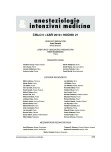Application of recombinant factor VIIa for refractory bleeding in patients with liver trauma – case reports
Authors:
Mannová Hillová Jitka 1; Seidlová Dagmar 1; Mašek Michal 2; Zimová Iveta 1; Ševčík Pavel 1
Authors‘ workplace:
Klinika anesteziologie, resuscitace a intenzivní medicíny FN Brno, Lékařská fakulta MU Brno
1; Klinika úrazové chirurgie FN Brno, Lékařská fakulta MU Brno, ČR
2
Published in:
Anest. intenziv. Med., 21, 2010, č. 5, s. 239-244
Category:
Intesive Care Medicine - Case Report
Overview
Surgical treatment is required in unstable trauma patients with liver damage and patients with grade IV–V liver trauma. The practice of damage control surgery has become widely accepted as a standard strategy in the management of these patients. A necessary part of the complex treatment must be the management of coagulopathy. Application of recombinant factor VIIa has shown to be effective when other modalities had failed.
Recombinant factor VIIa (rFVIIa ) treatment in patients with extensive liver damage is presented in three case reports. In the first one, the rFVIIa was administered for the treatment of coagulopathy when standard therapy had failed, in the second case to control refractory bleeding in liver trauma after performing peri-hepatic packing, and the last one in patients with progressive intra-parenchymal hepatic bleeding in whom surgical treatment had not been recommended. Questions remain about the optimal dosing of rFVIIa, the timing of treatment, administration of additional doses and the frequency of thrombo-embolic events.
Keywords:
liver trauma – bleeding – coagulopathy – recombinant factor VIIa
Sources
1. Ahmed, I., Beckingham, I. J. Liver trauma. Trauma, 2007, 9, p. 171–180.
2. Feliciano, D. V. Surgery for Liver Trauma. Surgical clinics of North America, 1989, 69, p. 273–284.
3. Reed, R. L., Merrell, R. C., Meyers, W. C. Continuing Evolution in the Approach to Severe Liver Trauma. Ann Surg., 1992, p. 216, 524–538.
4. Parks, R. W., Chrysos, E., Diamond, T. Management of liver trauma. BJS, 1999, 86, p. 1121–1135.
5. Holcomb, J. B. Use of Recombinant Activated Factor VII to Treat the Acquired Coagulopathy of Trauma. J. Trauma, 2005, 58, p. 1298–1303.
6. Uhlmann, E. J., Eby, CH. S. Recombinant activated factor VII for non-hemophiliac bleeding patients. Current Opinion in Hematology, 2004, 11, p. 198–204.
7. Haas, T. et al. Successful Reversal of Deleterious Coagulopathy by Recombinant Factor VIIa. Anesth. Analg., 2005, 100, p. 54–58.
8. Barletta, J. F., Ahrens, CH. L., Tyburski, J., Wilson, R. F. A Review of Recombinant Factor VII for Refractory Bleeding in Nonhemophilic Trauma Patients. The Journal of Trauma Injury, Infection and Critical Care, 2005, 58, p. 646–651.
9. Klitgaard, T., Palacios, R. T., Boffard, K. D. et al. Pharmacokinetics of recombinant activated factor VII in trauma patients with severe bleeding. Critical Care, 2006, 10.
10. Gasperi, A. D. Intraoperative use of recombinant activated factor VII (rFVIIa). Minerva Anestesiol., 2006, 72, p. 489–494.
11. Pépion, C., Becq, M. CH., Jacob L. Deep Vein Thrombosis after Recombinant Factor VIIa Infusion to Control Severe Recurrent Postoperative Bleeding. Anesthesiology, 2006, 104, p. 892–893.
12. Roberts, H. R. Recombinant factor VIIa (Novoseven) and the safety of treatment. Semin. Hematol., 2001, 38, p. 48–50.
Labels
Anaesthesiology, Resuscitation and Inten Intensive Care MedicineArticle was published in
Anaesthesiology and Intensive Care Medicine

2010 Issue 5
Most read in this issue
- Recombinant activated factor VII (rFVIIa) in the treatment of life threatening post-partum haemorrhage – data from the UniSeven clinical registry in the Czech Republic
- Application of recombinant factor VIIa for refractory bleeding in patients with liver trauma – case reports
- Effect of early use of high frequency oscillation in children with respiratory failure
- Spontaneous delivery during ECMO for H1N1 pneumonia-related ARDS – case report
